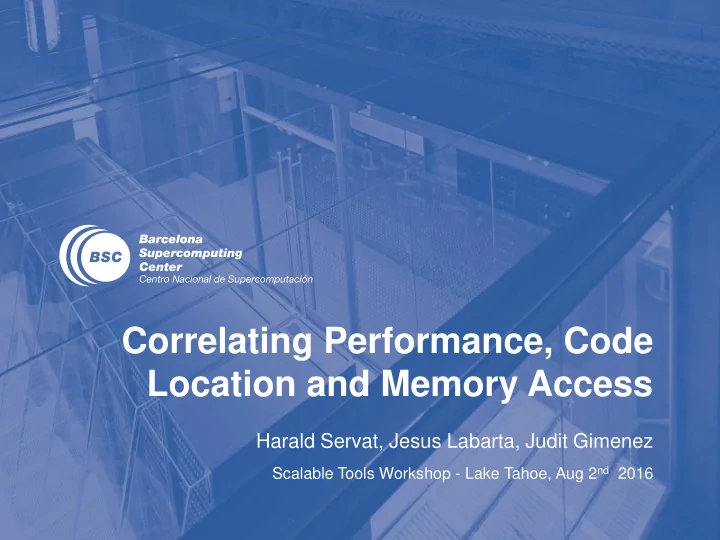

Correlating Performance, Code Location and Memory Access Harald Servat, Jesus Labarta, Judit Gimenez Scalable Tools Workshop - Lake Tahoe, Aug 2 nd 2016 1
Folding: instantaneous metric with minimum overhead Combine instrumentation and sampling – Instrumentation delimits regions (routines, loops, …) – Sampling exposes progression within a region Capture performance counters and call-stack references Initialization Iteration #1 Iteration #2 Iteration #3 Finalization Synth Iteration 2 2
Adding PEBS to Paraver traces Memory related data in the trace – PEBS events • Loads: address, cost in cycles, level providing the data • Stores: only address • Sampling frequency: – Possibly different rate for both loads and stores – One entry PEBS buffer. Signal Extrae on individual event. • Multiplexing: alternate periods sampling loads and stores 3 3
Memory object references Memory related data in the trace – Interception of mallocs and frees • Emit object id/call stack • With threshold on allocated size (potential unresolved objects) – Identification of memory object on sampled references • Static object from symbol table Identify variable name • Dynamic objects from instantaneous memory map Identify malloc where object was allocated Observation – Same source code different per process address space • Randomization Linux security Different Different base addresses most frequent Insight buffers – Folding should be applied on a per process basis 4 4
Analytics Identification of coarse grain repetitive structure (prerequisite) – Computation bursts • Between calls to the runtime (MPI, OpenMP) • Clustering – Iteration (longer intervals with runtime calls) • Manually: – Extrae_event API call – Paraver analysis • Automatic: Using spectral analysis (WIP) • Clustering – Isolate different modes, eliminate outliers Folding generates: – Gnuplot – Paraver trace • All PEBS related events are projected and ordered into a representative instance of the repetitive region • The same Paraver configuration files can be applied 5 5
Looking at Lulesh: 1. Performance 27 MPI ranks in 2 nodes (2 sockets x 12 cores each node) MPI calls Useful duration Useful instructions 6 6
Looking at Lulesh: 1. Performance Histogram useful duration Process mapping Histogram clock frequency Histogram useful instructions 7 7
Looking at Lulesh: 1. Performance One iteration 4 tasks selected 8 8
Looking at Lulesh: 2. Code location Approximation based on call stack @ MPI calls Approximation based on folded call stack 9 9
Looking at Lulesh: 3. Memory access PEBS address 10 10
Looking at Lulesh: 3. Memory access PEBS address 11 11
Looking at Lulesh: 3. Memory access PEBS level providing the data LFB L2 L3 DRAM 12 12
Looking at Lulesh: 3. Memory access PEBS cost in cycles (avg.) 13 13
Looking at Lulesh: Comparing gnuplots Architecture impact Stalls distribution Task 21 Task 23 14 14
Conclusions Folding can provide low overhead detailed analysis on accesses to memory – Wide range of new metrics: access pattern, memory objects, memory level, cost in cycles,… Paraver provides huge flexibility combining and correlating the new data :) – Only required to implement new “paint as” punctual information How much far/close to reverse engineering? 15 15
Recommend
More recommend